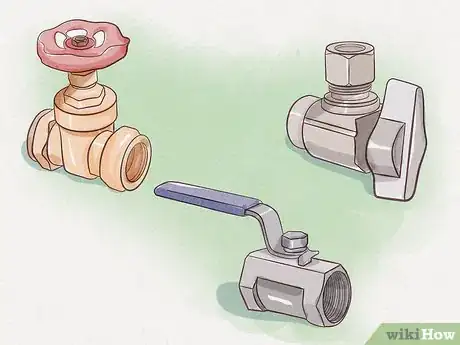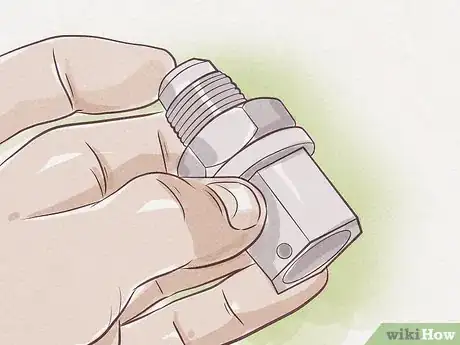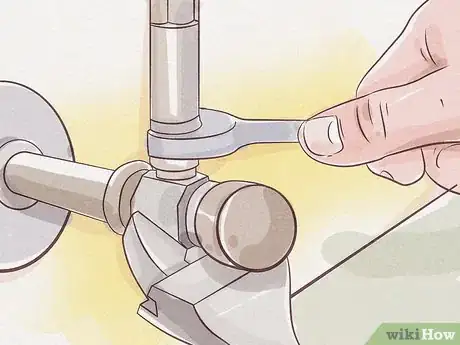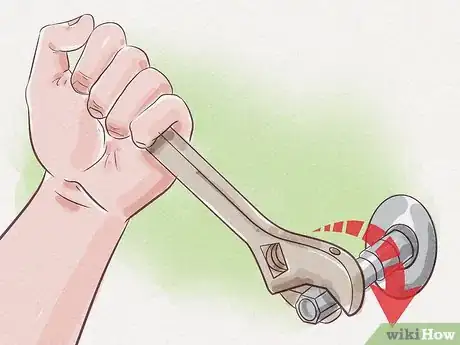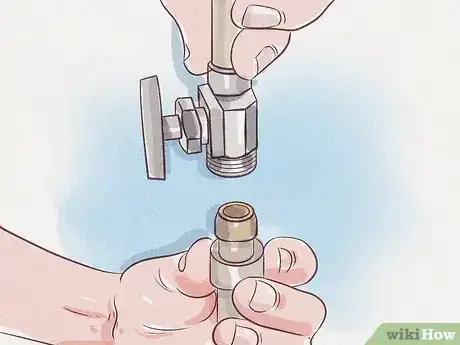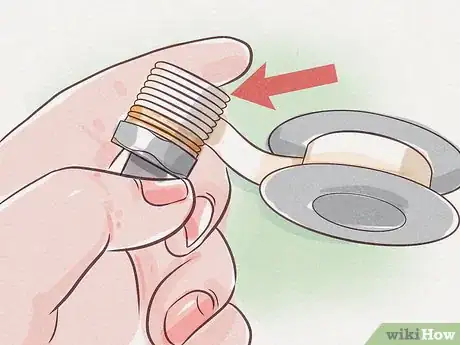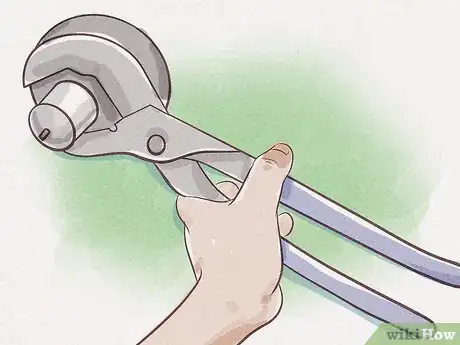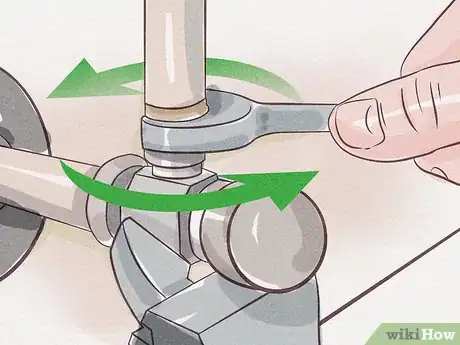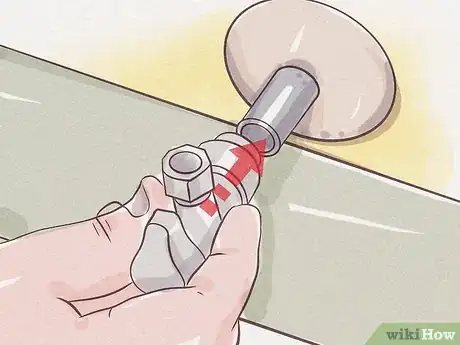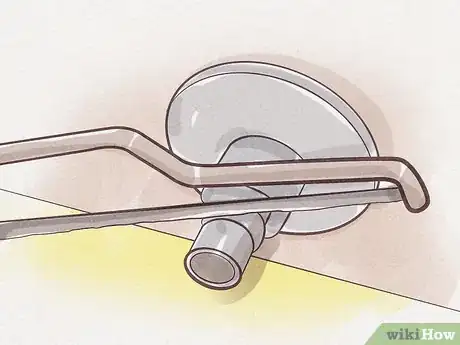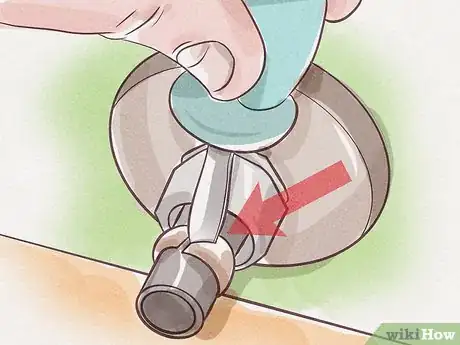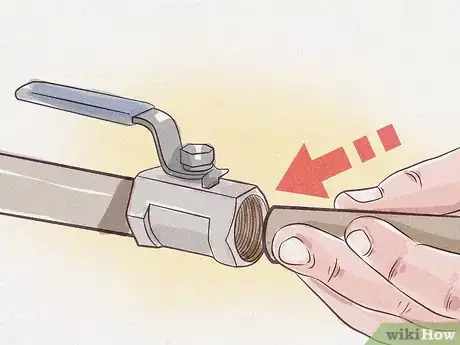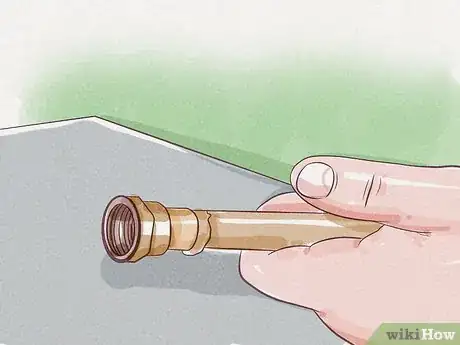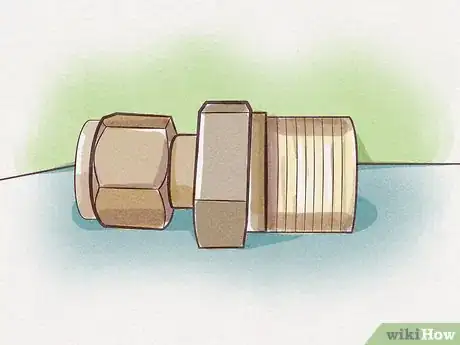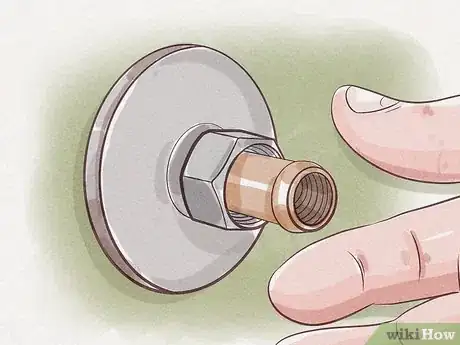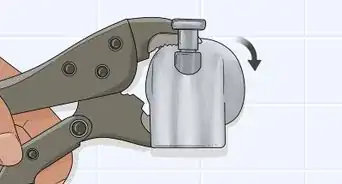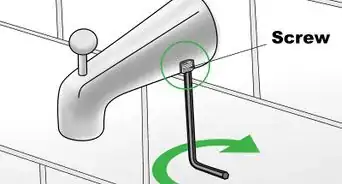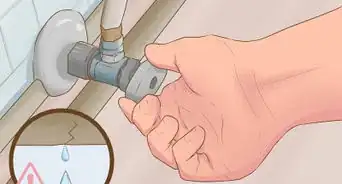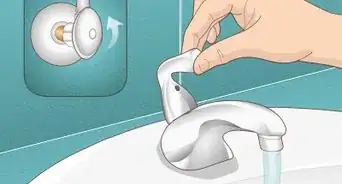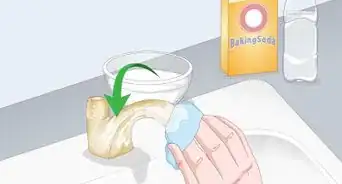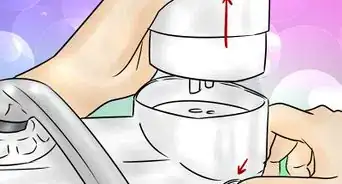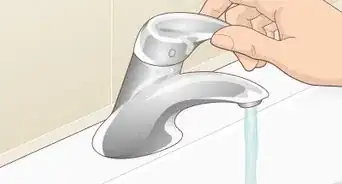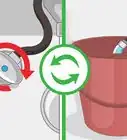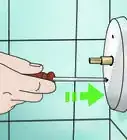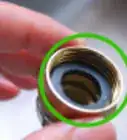This article was co-authored by James Schuelke. James Schuelke, along with his twin brother David, is the co-owner of the Twin Home Experts, a licensed plumbing, leak detection, and mold inspection company based in Los Angeles, California. James has over 32 years of home service and business plumbing experience and has expanded the Twin Home Experts to Phoenix, Arizona and the Pacific Northwest.
There are 14 references cited in this article, which can be found at the bottom of the page.
This article has been viewed 35,255 times.
Replacing a water valve is usually a relatively simple project, even if you don't have much experience working with plumbing. We'll walk you through figuring out what kind of valve you have, locating your main water shutoff, and even what to do if the valve is stuck.
Steps
Beginning Your Plumbing Project
-
1Identify your valve type. There are 3 types of valve connections, and your project's level of difficulty depends on how the valve connects to the water supply line. A threaded valve screws directly onto the water supply line and is easy to replace. In a compression connection, the valve screws into a hexagonal nut that fits around the supply line. The most difficult type to replace is a sweat valve, which is soldered onto the supply pipe.[1]
- If you see a hexagonal (6-sided) nut, you'll know you have a compression valve.
- A threaded valve will have 2 to 6 flat sides where it meets the supply line. These flat sides allow you to remove the valve with a pipe wrench.
- If you have a sweat valve, you'll be able to see where the valve body is soldered, or melted, into the water supply line. You can cut off a soldered sweat valve and replace it with a compression fitting as long as the remaining supply line is long enough to hold the new valve's compression nut and sleeve.
-
2Call a professional if your supply line is old or corroded. Regardless of your valve type, some jobs are better left to a professional plumber. If you have an older home with original plumbing, it's wise to have a professional replace valves. If you remove the valve and find that the pipe is internally rusted or threads are rotted, have a plumber install a replacement supply pipe.[2]Advertisement
-
3Purchase a valve that fits the supply lines. The new valve needs to fit the main supply pipe and the lines to any fixtures (such as a sink or toilet) it feeds. If you're not confident that you can find the right size, remove the old valve, bring it to the hardware store, and ask an employee to help you find a match.[3]
-
4Shut off the water supply.[4] Before you replace your valve, you'll need to locate your main valve and shut off the water supply. After shutting off the water, turn on the faucets on each level of your home to drain remaining water from the system.[5]
- If you need to replace your home's main valve, call your utility company and have them shut off your lot valve.[6]
-
5Remove any supply lines that lead from the faulty valve. After shutting off the water and draining the system, use a pipe wrench to loosen any supply lines that lead from the valve to fixtures. These supply lines are usually flexible braided pipes, and they run from the valve to a faucet or toilet.[7]
Replacing a Threaded Valve
-
1Remove the valve by turning it counter-clockwise. If you have a threaded valve, all you need to do is twist it off the supply pipe. Affix a pipe wrench to the flat sides where the valve body connects to the pipe. Rotate it counter-clockwise to loosen and remove it.[8]
- Remember to shut the water off before attempting to replace the valve.
-
2Inspect the exposed threaded supply line. With the old valve removed, check inside the pipe for rust or corrosion. Ensure the threads are intact and will be able to receive the new valve.[9]
- Call a plumber if your pipe is rusted or if the threads are rotted.
-
3Replace the old Teflon thread tape. You'll likely find Teflon thread tape at the end of the pipe. Peel it off and discard it, and double check that the threads are intact. Then place a new strip of tape over the threads.[10]
- You can find Teflon thread tape online or at a hardware store.
-
4
-
5Reconnect supply lines to the new valve. After screwing the valve onto the main pipe, use the pipe wrench to reattach any supply lines that lead to fixtures, such as a faucet or toilet. Tighten them until you encounter resistance, but don't tighten them to the point that it's impossible to remove them.[13]
-
6Turn the water back on and check for leaks. When you turned off the water supply at the start of the project, you turned on faucets to drain the system. Make sure the faucets are turned off, then turn on the water supply. Check the valve you replaced for leaks and turn on (or flush) any fixtures it feeds.[14]
- Tighten the valve with the pipe wrench if it leaks.
Replacing a Compression Valve
-
1Loosen the compression nut by turning it counter-clockwise.[15] Ensure that the water supply is off before removing the valve. Affix a pipe wrench to the 6-sided nut that holds the valve body in place. Rotate it counter-clockwise to loosen it from the valve body.[16]
- The compression nut is a ring that fits around the pipe. After loosening it from the valve body, you can slide it down the pipe shaft and remove the valve.
- You'll follow this step only if your existing valve uses a compression fitting. If you're replacing a threaded or sweat valve with a compression valve, you'll need to cut the soldered or threaded end of the pipe before you install the new valve.
-
2Remove the old valve and compression sleeve. With the compression nut loosened, simply pull the old valve off of the pipe. Locate the compression sleeve, which is a ring that fits snugly at the end of the pipe. Use pliers to carefully rotate it and remove it from the pipe, then slide off the compression nut.[17]
- Don't use too much pressure with the pliers. If you warp the pipe, it won't receive the new valve.
-
3Cut the old compression sleeve if it's stuck. If you can't remove the ring with pliers, cut it carefully with a small hacksaw. Insert a flat-head screwdriver into the slice you made in the ring, then twist the screwdriver to widen the ring. Pull the ring off the pipe, then slide off the old compression nut.[18]
- Cut with finesse and make sure you don't cut through the ring into the pipe.
-
4Cut an old soldered or threaded supply pipe, if necessary. If you're replacing a sweat or threaded valve with a compression valve, use a hacksaw to cut off the soldered or threaded end of the pipe. Cut slowly and carefully to avoid warping the pipe. Sand away rough edges with emery cloth when you've finished cutting.[19]
- Make sure you leave enough pipe to hold the new fitting. Depending on the size of your new valve, you'll probably need at least 2 inches (5.1 cm).
-
5Loosen or cut the pipes on each side of a 2-way valve. You'll need to remove piping at both ends if you're replacing a 2-way valve (as opposed to a pipe that comes out from a wall and feeds a faucet or toilet). If the pipes are old, corroded, or soldered onto the valve, cut each pipe just past where they connect to the valve.[20]
- If the pipes connect to a 2-way valve with compression fittings, just loosen each compression nut.
-
6Slide the new compression nut and sleeve onto the supply pipe. Make sure the threaded end of the new nut faces out so it can receive the new valve. Slide it all the way down the pipe so you have some room to work. Then place the new compression sleeve over the end of the pipe.[21]
- The compression sleeve, or ferrule, needs to fit snugly. It creates a watertight seal between the valve and the pipe. If you purchased a valve that matches your pipe's diameter, the compression sleeve will be snug.
-
7Thread the valve into the compression nut. Place the valve on the end of the pipe, then pull the compression nut down the pipe's shaft to the threaded end of the valve body. Rotate the nut clockwise by hand, then use a pipe wrench to finish tightening it.[22]
- If you're replacing a 2-way valve, tighten the compression nuts on both ends.[23]
-
8Reattach supply lines, if necessary. If your valve feeds a faucet, toilet, or other fixture, replace the supply lines that lead from the valve to the fixture. Start them off by hand, then finish tightening them with the pipe wrench. Make sure they're not so tight that it's impossible to remove them in the event that they need service in the future.[24]
-
9
Expert Q&A
-
QuestionWhat are the first steps of replacing a water shutoff valve?
 James SchuelkeJames Schuelke, along with his twin brother David, is the co-owner of the Twin Home Experts, a licensed plumbing, leak detection, and mold inspection company based in Los Angeles, California. James has over 32 years of home service and business plumbing experience and has expanded the Twin Home Experts to Phoenix, Arizona and the Pacific Northwest.
James SchuelkeJames Schuelke, along with his twin brother David, is the co-owner of the Twin Home Experts, a licensed plumbing, leak detection, and mold inspection company based in Los Angeles, California. James has over 32 years of home service and business plumbing experience and has expanded the Twin Home Experts to Phoenix, Arizona and the Pacific Northwest.
Professional Plumber First, make sure you turn off the main water supply to your home so you don't cause any leaks. Make sure to have towels and buckets ready so you can drain the water that's in the pipes.
First, make sure you turn off the main water supply to your home so you don't cause any leaks. Make sure to have towels and buckets ready so you can drain the water that's in the pipes.
Things You'll Need
- New valve that fits your pipe
- Pipe wrench
- Hacksaw, if necessary
References
- ↑ https://www.familyhandyman.com/plumbing/valves/how-to-replace-a-shutoff-valve/view-all/
- ↑ https://www.familyhandyman.com/plumbing/valves/how-to-replace-a-shutoff-valve/view-all/
- ↑ https://www.youtube.com/watch?v=PFhvVMGuXJE&feature=youtu.be&t=115
- ↑ James Schuelke. Professional Plumber. Expert Interview. 1 October 2019.
- ↑ https://www.thisoldhouse.com/ideas/adding-sink-shutoff-valves
- ↑ https://www.familyhandyman.com/plumbing/valves/home-repair-how-to-replace-the-main-shut-off-valve/view-all/
- ↑ https://www.youtube.com/watch?v=PFhvVMGuXJE&feature=youtu.be&t=85
- ↑ https://www.youtube.com/watch?v=PFhvVMGuXJE&feature=youtu.be&t=97
- ↑ https://www.familyhandyman.com/plumbing/valves/how-to-replace-a-shutoff-valve/view-all/
- ↑ https://www.youtube.com/watch?v=PFhvVMGuXJE&feature=youtu.be&t=120
- ↑ James Schuelke. Professional Plumber. Expert Interview. 1 October 2019.
- ↑ https://www.youtube.com/watch?v=PFhvVMGuXJE&feature=youtu.be&t=128
- ↑ https://www.youtube.com/watch?v=PFhvVMGuXJE&feature=youtu.be&t=132
- ↑ https://www.youtube.com/watch?v=PFhvVMGuXJE&feature=youtu.be&t=159
- ↑ James Schuelke. Professional Plumber. Expert Interview. 1 October 2019.
- ↑ https://www.familyhandyman.com/plumbing/valves/how-to-replace-a-shutoff-valve/view-all/
- ↑ https://www.familyhandyman.com/plumbing/valves/how-to-replace-a-shutoff-valve/view-all/
- ↑ https://www.familyhandyman.com/plumbing/valves/how-to-replace-a-shutoff-valve/view-all/
- ↑ https://www.homedepot.com/c/install_shutoff_valve_HT_PG_BA
- ↑ https://www.youtube.com/watch?v=D0ftheIfTjY&feature=youtu.be&t=114
- ↑ https://www.familyhandyman.com/plumbing/valves/how-to-replace-a-shutoff-valve/view-all/
- ↑ https://www.homedepot.com/c/install_shutoff_valve_HT_PG_BA
- ↑ https://www.youtube.com/watch?v=D0ftheIfTjY&feature=youtu.be&t=175
- ↑ https://www.homedepot.com/c/install_shutoff_valve_HT_PG_BA
- ↑ James Schuelke. Professional Plumber. Expert Interview. 1 October 2019.
- ↑ https://www.familyhandyman.com/plumbing/valves/how-to-replace-a-shutoff-valve/view-all/
